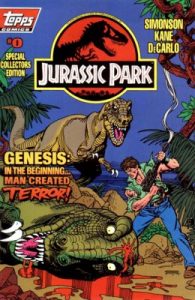After the success of the movie in June 1993, “Jurassic Park” fans didn’t have to wait long for follow-up stories. Arguably, they had to wait awhile for GOOD stories, as the next novel and movie came out in 1995 and 1997, respectively. But Topps Comics – which also got the license for 1993’s other pop-culture smash, “The X-Files” – quickly cranked out further “Jurassic Park” adventures.
First up was a special Issue 0 (September 1993), penned by Walter Simonson and featuring cynical Gennaro and Nedry’s first tours of the park. Gennaro is unimpressed, whereas Nedry realizes the value of the embryos. The best way to get this rare issue is in IDW’s “Classic Jurassic Park” Volume 2. After Simonson’s four-issue film adaptation came the first further adventures: The “Raptor” trilogy (1993-94), from the pen of Marvel veteran Steve Englehart. These 10 issues – “Raptor” (1-2), “Raptors Attack” (1-4) and “Raptors Hijack” (1-4) – were soon after reprinted for newsstands as “Jurassic Park Adventures” 1-10.
The “Raptor” trilogy reintroduces our heroes from the movie, the InGen-BioSyn rivalry, and the film’s breakout dinosaur species. In shades of “Jurassic Park III,” Englehart explores raptor communication and child rearing — and even shows us the inner thoughts of the beasts.
Unfortunately, the characters become caricatures: Ellie is torn between Grant and Malcolm (she even desires romantic time with Grant AS THEY ARE HUNTING RAPTORS!), Malcolm mutters about chaos theory without saying anything new, and Muldoon inexplicably comes back from the grave to hunt down the three escaped raptors (named Alf, Betty and Celia) in South America. The plots are insane: A Columbian drug lord is ready with shock collars and an enclosure when he stumbles upon the raptors, a scientist who is training a gorilla uses sign language to successfully communicate with the raptors and keep them from killing her, and BioSyn assembles its version of Jurassic Park in the jungle by fencing in the raptors.
These ideas aren’t bad in and of themselves, but the plots unfold illogically fast. The trailer for “Jurassic World” features Chris Pratt’s character calmly riding his motorcycle with raptors on either side. But it’s one thing for top scientists to figure out how to train and control raptors over the course of a decade, and quite another for a drug lord to do it in a matter of days, and on a whim.
Whereas the Costa Rica government napalm-bombs Isla Nublar at the end of Crichton’s novel, we learn in “Raptor” Issue 1 that Jurassic Park remains in place in the movie/comic timeline. InGen’s people are cleaning up the mess three days later, and the opening panels set the odd tone of the “Raptor” saga: Using shock prods and tranquilizer darts, InGen’s men bring down the T-rex, but no one seems particularly shaken by the encounter. Even though Grant tells Ellie “I’ll never get used to this,” before long the duo purposely tromps into a raptor cave on the other side of the island armed only with a shotgun. No doubt Englehart was inspired by the end of Crichton’s book, where Grant resolves to count the raptor eggs; in the comic, similarly, he wants to prove to the InGen people that there are raptors on the loose.

As the comics go forward, our heroes are increasingly blasé about facing off with raptors. After being kidnapped along with the raptors by BioSyn, Grant and Ellie even take up roles as the raptors’ protectors, which is insane. While I like Englehart’s idea of getting into the heads’ of the raptors, it seems odd that the raptors would choose to not kill Ellie because she nursed Celia back to health or would leave Dr. Belvedere unscathed because she uses the sign for “peace.” (And how would raptors know sign language, anyway?) Raptors are killing and eating machines, not creatures with a moral compass, and they’re street smart, not book smart. Sure, if something’s in it for them – like the return of their eggs in “Jurassic Park III” – they’re smart enough to play along, but I doubt they have a sense of fair play. I do like their escape from BioSyn’s makeshift park in “Raptors Hijack” though: They dig under the walls.
If the silliness of this series wasn’t already obvious, it becomes clear in “Raptors Attack” Issue 2 when Muldoon returns:
Malcolm: “I thought you were dead!”
Muldoon: “Hell, the raptors tried, but I’d raised them — I knew their hunting tricks!”
If that’s not stupid enough, the drug lord soon uses his trained raptors as attack beasts against his political opponents in broad daylight.
Outstanding art might have salvaged these books, but – coming from a variety of artists — it’s mediocre and inconsistent. The best I can say is that I can always tell who’s who and what’s happening, but there’s never a sense of mood. The covers by Michael Golden – loosely based on the inside action — are pretty great, though.
By the end of the final issue of the “Raptor” trilogy, the chase is over, two adult raptors and several babies are loose in the Central American jungle, and we’re back to a central concern of Crichton’s books: Dinosaurs being loose on the mainland. While the four heroes aren’t thrilled with the raptors’ escape, they decide to give up not only the hunt, but also their scientific and moral principles, as they drink daiquiris in Venezuela:
Muldoon: “We’ll never track them now, not in 10,000 square miles of jungle!”
Ellie: “Maybe it’s just as well! They’re dangerous, but so are tigers and cobras, and we don’t cage all of them!”
Grant: “I agree! We’ve done our best – now I say let nature sort it out!”
While I have no doubt it’s hard to translate “Jurassic Park’s” mix of horror, wonder and adventure into this medium, there’s no excuse for abandoning the main characters’ core beliefs and tethers on reality. That final page is particularly ridiculous, but it sums up these “Raptor” comics all too well.

Addendum on June 4, 2018:
I picked up “Jurassic Park” Issue 0 on eBay, packaged with the trade paperback of the movie adaptation. So I’ll have to sell my individual issues of the movie adaptation to avoid redundancy in my longboxes (#firstworldproblems). It’s nice to complete my collection of “JP” fiction with this special issue, which includes lawyer Donald Gennaro’s introduction to the park in “Genesis” and computer man Dennis Nedry’s first look in “Betrayal.” Both are written by Walter Simonson with pencils by Gil Kane.
Both play like deleted sequences from the movie. Neither is a strictly necessary story, but “Genesis” does feature the (implied) first successful dinosaur hatching – of a T-rex. While Gennaro is the audience surrogate, doing his usual worrying about the cost of the park, the story gives more insight into John Hammond, who screens clips from beloved old dinosaur movies to try to inspire the lawyer. Kane’s likenesses of the characters aren’t great, but I like the opening panels that focus on the buckets of the Earth-movers, which resemble T-rex mouths. Since this is all in good fun, I’ll give a free pass to the closing joke where Gennaro claims he wouldn’t leave a men’s room to look at a dinosaur.
“Betrayal” is more straightforward, although it has an artistic edge since Kane nails Nedry’s likeness. It’s basically Nedry whining about being underpaid – despite getting four times his usual rate – and then realizing that he can steal embryos and get a payday on the side. The only sequence of dino action finds a T-rex being repeatedly shocked by the electro-fence as he tries to get at Nedry, who is lounging against it.

